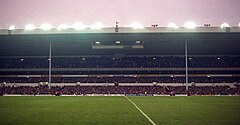In 1962, 2,600 seats were fitted at the back of the South Stand (on Park Lane), followed the next year by 3,500 seats at the North (Paxton Road) Stand, which was further extended in 1968 to link up with the West Stand to give a further 1,400 seats.
[14] The South and West stands were linked in 1973 that added further seats, but the capacity of the ground dropped overall as seats replaced standing terraces.
In 1980, in a bid to improve facilities and upgrade what were then considered outdated stadium, a new phase of redevelopment began that would transformed the ground. The new chairman Arthur Richardson green-lit the project over the skepticism of previous chairman Sidney Wale.
[32] The old West Stand was demolished in November 1980 to be replaced by a new stand designed by Ernest Atherden that had 6,500 seats and featured 72 executive boxes.
[16] The new West Stand opened 15 months later on 6 February 1982 for a match against
Wolverhampton Wanderers, won by Spurs 6–1 with a hat-trick from
Ricky Villa.
[32] However, cost overruns in the project, which rose from £3.5 million to £6 million, and the cost of rebuilding the team resulted in financial difficulties for the club.
[32] Irving Scholar took advantage of a rift in the boardroom and bought out the shares of Wale, leading to a change of directors.
[33]

The East Stand in 1991 – the upper part of The Shelf had been replaced by executive boxes, but the remaining standing terraces had not yet been replaced by seats
In 1985, a plan to demolish and rebuild the East Stand was rejected by Haringey Council. In 1988, the club decided to proceed instead with a refurbishment of the East Stand despite objections by fans. The long stretch of raised standing terrace on the East Stand, known by fans as The Shelf,
[34] was redesigned to include the installation of executive boxes replacing the upper section of the standing terrace. Work on the East Stand however caused the opening game of the 1988–89 season against Coventry to be postponed a few hours before kickoff.
[16][35] The East Stand was closed that season. Work on the stadium continued in the summer of 1989 and the refurbished East Stand opened on 18 October 1989 for the
North London Derby.
[14] The cost of the project however doubled to over £8 million; this, together with other financial problems, would again led to a change of directors at the club in 1991.
[33]



